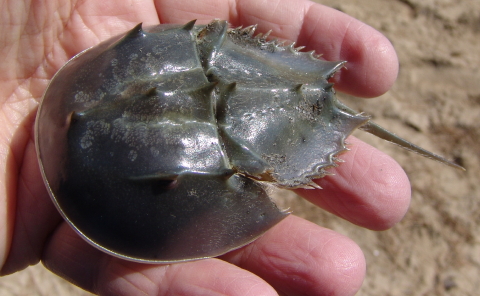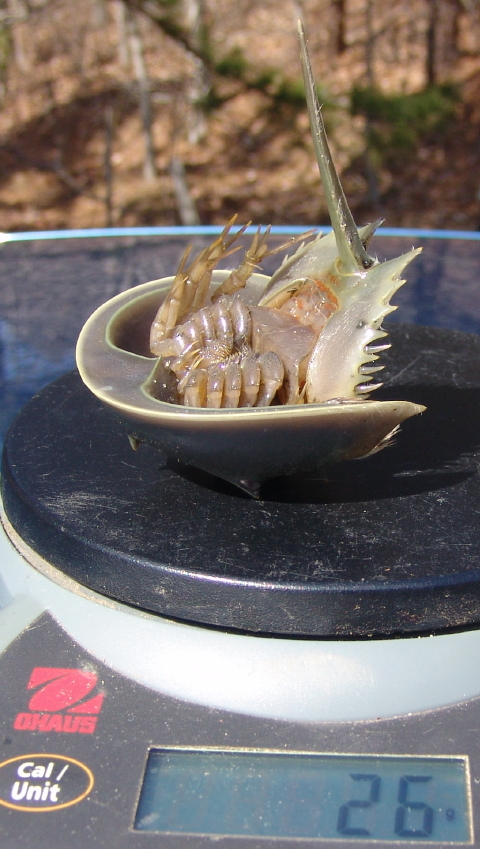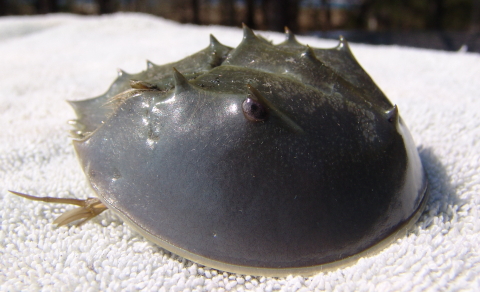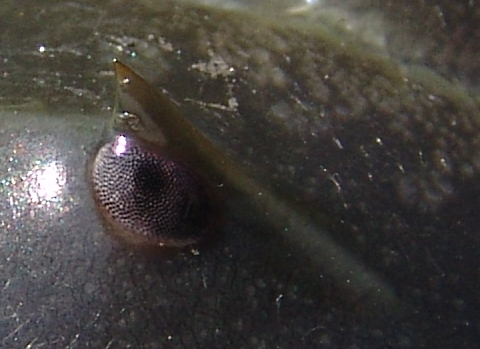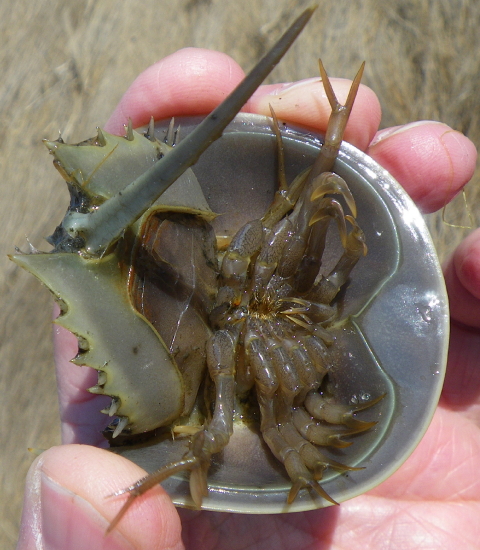Juvenile Horseshoe Crab (Limulus polyphemus)
March madness means something entirely different to the Turtle Journal team. Yes, it’s a culmination of a long winter of preparation. Yes, we must keep our eyes on the ball. And, yes; there’s an awful lot of bouncing around. Not on basketball courts, mind you. But at every natural habitat from wetlands to ocean. This glorious afternoon, with full sunshine, gentle southerly breeze and mid-50s temperature, Turtle Journal ventured to the rich salt marshes of South Wellfleet to check on the emergence of juvenile horseshoe crabs; another important signpost on the road to spring.
Capture of Juvenile Horseshoe Crab
We examined the shallow marsh channels off Blackfish Creek where we usually find the emergence of the first juvenile horseshoe crabs of the year. We had been here a week ago with no sign of activity; not even tiny fish swimming in the channels and playing hide & seek among the marsh reeds. Yet, today we found several tracks of juvenile horseshoe crabs in the oozy bottom. Then, almost impossible to see through the murk, a blurry mud trail betrayed the camouflaged presence of a juvenile specimen, and Don Lewis swept into action with his sampling net.
Massing Juvenile Horseshoe Crab
This youngster tipped the scales at 26 grams with tail (telson) pointed skyward like an exclamation point!Â
Examination of Juvenile Horseshoe Crab
The anterior carapace (prosoma) measured 6.1 centimeters maximum width and 4.2 centimeter long. The posterior (abdominal region or opisthosoma) measured 3.1 centimeters length from hindge to notch and 4.2 centimeters wide. The spiny tail (telson) measured 4.8 centimeters.
Juvenile Horseshoe Crab Compound Eye
Don especially delighted in the clear view of the critter’s compound eyes as illustrated in the photograph above.
Juvenile Horseshoe Crab Ventral View
This ventral view reinforces the impression that folks have that horseshoe crabs, whether juveniles or adults, are an ancient creature; a living fossil. When they molt, and horseshoe crabs like lobsters must molt frequently to grow, the shell splits at the leading ventral edge of the anterior carapace (prosoma), so that the animal can wiggle to freedom, then create and harden a new, larger shell. When you find horseshoe crab shells along the beach, check for this slit to determine whether you have discovered an abandoned shell of a freshly molted individual.
Rusty Colored Substance on Book Gills
On today’s specimen, we notice a rusty coloration on and immediately behind the book gills.
Â
Release of Juvenile Horseshoe Crab
While finding the first juvenile horseshoe crab of the year is a cherished experience in our rite of spring, it is only exceeded by the joy of releasing that specimen back into the wild once it has yielded a little scientific data. Today’s juvenile slid as gracefully as a horseshoe crab can into the marsh channel and floated down to the bottom. After a minute or so of orientation, it wobbled forward to find the perfect spot under the marsh rim to burrow down for some peace and quiet. Humans are, after all, strange critters that can be taken only in small doses.
Juvenile Horseshoe Crab Ventral View
Turtle Journal confesses to finding horseshoe crabs irresistible. During mating season, which should commence in another month or so, our wading boots get “checked out” by amorous males that get fooled by the enticing dark color and lovely rounded edges. We’re facinated by intricate artistic designs carved on beaches by females and males locked in embrace after depositing eggs at high tide. And there’s nothing so noble, yet comical as a juvenile horseshoe crab that stomps across your palm marching towards freedom. Just for the record, these living fossils are darn good for the tidal ecosystem where they’re constantly tilling and aerating soil with ten walking legs and two feeding pincers. Horseshoe crabs eggs provide the most nutrious food for migrating shorebirds, and their blue blood presents a modern medical and scientific miracle for disease detection, for thwarting bioterrorism and even for facilitating planetary exploration probes. No wonder Turtle Journal delights in marking each spring with the arrival of the next generation of horseshoe crabs!
